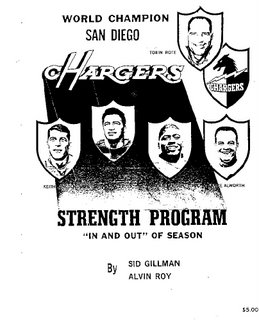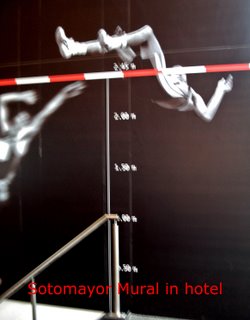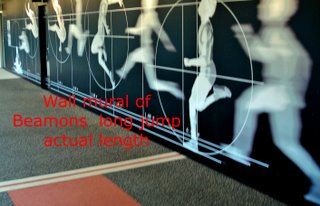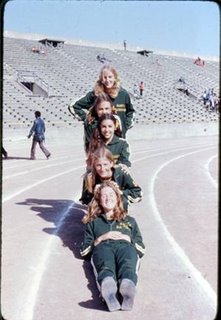Bill Knowles is an ATC and CSCS who is one of the most innovative people I know. His knee rehab ideas and progressions have really opened my eyes. Bill is at iSPORT TRAINING-Vermont Orthopaedic Clinic in Killington, Vermont (www.isporttraining.com). I first met Bill when he was at Burke Mountain Academy in Vermont. He did the conditioning for Hanah Teeter, Gold medalist in Snowboarding at Torino.
What are the most essential requirements for a successful conditioning program?
Experienced staff to design and implement it.
A spacious and motivating environment.
The ability to put the athletes needs first.
What are the most common mistakes in conditioning?
Failing to plan.
What is “functioning training” from your point of view?
Applying resistance or load to a sport specific movement pattern. Perhaps instead of “functional training” we can call it movement specific strength and conditioning.
What do you do to make your training more functional?
I watch a great deal of sports, and I continue to play or practice multiple sports. This experience is critical to feel what the athletes feel. You then need to be confident and innovative to apply resistance to what is really going on in the sport.
How important is specificity?
That depends on the sport. If it is the javelin throw, you need to be very specific. Field sport athletes have more room to develop strength that will benefit them for multiple movements…which is specifically what they do! The higher the skill level of the athlete, the more specific the conditioning needs to be, and visa versa.
What aspect of conditioning athletes is most difficult and how have you tried to address it?
Accepting mediocrity.
I don’t accept it anymore
With the plethora of information available how can you determine what is best?
Experience. You must slowly work through training concepts and program designs to gain the experience and learn what works best. There is no ONE right way. And there are no shortcuts.
Where do you stand on nature versus nurture? How much difference can training make?
Everyone has genetic potential. Training has the opportunity to develop that potential fully. But, there are large disparities in genetic make up. This usually surfaces as the athletes mature. Training can make an average athlete become above average. Genetic make up allows an individual to become “above” above average. Training is crucial to support this as well.
What is the sure sign that a self proclaimed conditioning guru is not a good source of advice?
That they have the answers, or the “best” method to develop athletes. I once heard a top professional say their program made a “humongous” difference in an athlete’s situation. I’m unaware of that term in the research literature. Unless it is grouped up with a “shit load” as degree of measurement.
What do you do differently with the female athlete in terms of conditioning?
Slightly higher feedback and consistent positive responses. Although, when an effort is poor they will hear about it. I also address the concerns in the research in regards to knee injury prevention training, etc.
What has been the biggest innovation in training that you have seen during the course of your career and where is the biggest room for innovation in training athletes?
The biggest innovation is education in the field of performance training versus strength training. This has allowed us to utilize what looks right in athlete development versus what have been the most accepted (traditional) methods to develop athletes.
The most room for innovation is in education. We must develop innovative ways to convince S&C coaches; and more importantly, those coaches who have little or no formal education in S&C that the WHY is significantly more important than the HOW! I am frustrated when coaches ask “what are the reps and sets” after I show them some new strength routines. So they now know HOW to do the exercise, but they don’t know WHY you perform 4x8 versus 5x25 seconds. Therefore, educate coaches and they will be more innovative in training athletes.
What’s the biggest issue in training athletes today?
Planning and program design. This is directly related to implementing an S&C program for a year-round female soccer player. When does she take the time strength train? Having a year-round plan is critical for the long term development of this individual. Especially when we consider injury prevention issues.
Who has been a role model in your career and why?
My first boss at a ski racing academy in Vermont. He was a former Olympic ski coach that had an unparalleled ability to instill passion and motivation with young athletes. His motivational speeches and lectures on being a good person, having self respect, respect for others, working hard, etc. were chilling at times. Another role model is a close friend of mine in Sarasota, Florida. As a strength coach he has given me the WHY, and I have run with it!
What are the biggest professional challenges you have had to face?
Justifying progressive rehabilitation and reconditioning programs to the medical profession. Traditionally most rehabilitation protocols are surgeon/physician driven. Their experience and understanding in how reconditioning principles can be applied safely and effectively is limited to their education in med school and current research. Sharing experiences of effective programs that are outside of the box has been a challenge, but none the less valuable experience. Fortunately I have surrounded myself with innovative and progressive surgeons on a regular basis.
What do you enjoy most about what you do? Dislike?
Well, I am sitting in Austria looking at the glaciers as we speak. Say no more! Additionally it is the satisfaction of teaching or coaching athletes into correct movements. If this produces gains in strength and ability to allow a return to performance after injury, or gets them a gold medal in the Olympics; the feeling is the same. It is the results of the athletes that make me the proudest.
Dislike: when you love your job it is easy to be totally committed to it and forget to take the time you should for yourself and family. Focused and committed athletes ask a lot of your time as well. The solution is simple; it’s all about balance.
Did there come a time in your career where you were faced with a “fork in the road”? If so, do you ever revisit the decision you made or didn’t make?
Yes. Developing progressive and innovative rehab and reconditioning programs always puts you in a position to be criticized. It is the occasional failure that others remember, not the dozens of successes. My programs are well planned and thought through, therefore I have no regrets of decisions I have made. Occasional failures are a critical part of moving forward if you are to stay on the cutting edge.
What inspired you to get into the field you are in?
I was inspired to get into Athletic Training through the interest of staying involved with athletics at a high level. I finished playing college soccer and wasn’t interested in stopping an athletic career.
As a rehab, reconditioning and strength training specialist: I moved into this field out of the necessity to provide a fully comprehensive program for athletes following injury. I was also surrounded by injury in an athletic environment and felt the need to develop better injury prevention training. This was accomplished through setting up sound S&C programs. Today I equally balance my time between prevention and recovery from injury.
Is failure ever valuable?
It is not only valuable, it is necessary. Hopefully the level of failure is not damaging to the athlete long term. Learning from yours and others mistakes only makes one stronger. Just don’t make too many!
Which change is now taking place in your field that should be encouraged, and which resisted?
Encouraged: The relationship between S&C and injury prevention, and S&C and performance enhancement.
Resisted: Only teaching the HOW to do something without the WHY behind it. We should also resist the temptation to become a “specialist” by taking a weekend course or mail-in program. We should resist the fact that a chart or book does not replace COACHING! Errors in movement patterns are not typically because of muscle tightness or weakness, but due to poor coaching and athlete preparation. Assessing movements is a coaches responsibility, not a therapists.



































